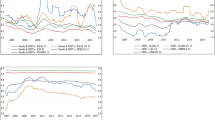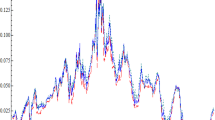Abstract
In this work, the pricing problem of a variable annuity (VA) contract embedded with a guaranteed lifelong withdrawal benefit (GLWB) rider has been considered. VAs are annuities whose value is linked with a sub-account fund consisting of bonds and equities. The GLWB rider provides a series of regular payments to the policyholder during the policy duration when he is alive irrespective of the portfolio performance. Also, the remaining fund value is given to his nominee, at the time of death of the policyholder. The appropriate modelling of fund plays a crucial role in the pricing of VA products. In the literature, several authors model the fund value in a VA contract using a geometric Brownian motion (GBM) model with a constant variance. However, in real life, the financial assets returns are not Normal distributed. The returns have non-zero skewness, high kurtosis, and leverage effect. This paper proposes a discrete-time model for annuity pricing using generalized autoregressive conditional heteroscedastic (GARCH) models, which overcome the limitations of the GBM model. The proposed model is analyzed with numerical illustration along with sensitivity analysis.









Similar content being viewed by others
References
Bacinello, A. R., Millossovich, P., Olivieri, A., & Pitacco, E. (2011). Variable annuities: A unifying valuation approach. Insurance: Mathematics and Economics, 49(3), 285–297.
Bauer, D., Kling, A., & Russ, J. (2008). A universal pricing framework for guaranteed minimum benefits in variable annuities. ASTIN Bulletin: The Journal of the IAA, 38(2), 621–651.
Bollerslev, T. (1986). Generalized autoregressive conditional heteroskedasticity. Journal of Econometrics, 31(3), 307–327.
Bühlmann, H., Delbaen, F., Embrechts, P., & Shiryaev, A. N. (1996). No-arbitrage, change of measure and conditional esscher transforms. CWI Quarterly, 9(4), 291–317.
Choi, J. (2017). Indifference pricing of a GLWB option in variable annuities. North American Actuarial Journal, 21(2), 281–296.
Chow, G. C. (1960). Tests of equality between sets of coefficients in two linear regressions. Econometrica: Journal of the Econometric Society, 28, 591–605.
Condron, C. M. (2008). Variable annuities and the new retirement realities. The Geneva Papers on Risk and Insurance-Issues and Practice, 33(1), 12–32.
Dai, M., Kuen Kwok, Y., & Zong, J. (2008). Guaranteed minimum withdrawal benefit in variable annuities. Mathematical Finance, 18(4), 595–611.
Drinkwater, M., Iqbal, J., & Montiminy, J. (2014). Variable anuity guaranteed living benefits utilization: 2012 experience. A joint study sponsored by the Society of Actuaries and LIMRA.
Engle, R. F. (1982). Autoregressive conditional heteroscedasticity with estimates of the variance of united kingdom inflation. Econometrica: Journal of the Econometric Society, 50(4), 987–1007.
Ericsson, J., Huang, X., & Mazzotta, S. (2016). Leverage and asymmetric volatility: The firm-level evidence. Journal of Empirical Finance, 38, 1–21.
Forsyth, P., & Vetzal, K. (2014). An optimal stochastic control framework for determining the cost of hedging of variable annuities. Journal of Economic Dynamics and Control, 44, 29–53.
French, K. R., Schwert, G. W., & Stambaugh, R. F. (1987). Expected stock returns and volatility. Journal of Financial Economics, 19(1), 3.
Glosten, L. R., Jagannathan, R., & Runkle, D. E. (1993). On the relation between the expected value and the volatility of the nominal excess return on stocks. The Journal of Finance, 48(5), 1779–1801.
Hardy, M. (2003). Investment guarantees: Modeling and risk management for equity-linked life insurance. Hoboken: Wiley.
Krayzler, M., Zagst, R., & Brunner, B. (2016). Closed-form solutions for guaranteed minimum accumulation and death benefits. European Actuarial Journal, 6(1), 197–231.
Ledlie, M., Corry, D., Finkelstein, G., Ritchie, A., Su, K., & Wilson, D. (2008). Variable annuities. British Actuarial Journal, 14(2), 327–389.
Nelson, D. B. (1991). Conditional heteroskedasticity in asset returns: A new approach. Econometrica: Journal of the Econometric Society, 59(2), 347–370.
Ng, A. C.-Y., Li, J. S.-H., & Chan, W.-S. (2011). Modeling investment guarantees in Japan: A risk-neutral garch approach. International Review of Financial Analysis, 20(1), 20–26.
Peng, J., Leung, K. S., & Kwok, Y. K. (2012). Pricing guaranteed minimum withdrawal benefits under stochastic interest rates. Quantitative Finance, 12(6), 933–941.
Piscopo, G., & Haberman, S. (2011). The valuation of guaranteed lifelong withdrawal benefit options in variable annuity contracts and the impact of mortality risk. North American Actuarial Journal, 15(1), 59–76.
Quittard-Pinon, F., & Randrianarivony, R. (2011). Impacts of jumps and stochastic interest rates on the fair costs of guaranteed minimum death benefit contracts. The Geneva Risk and Insurance Review, 36(1), 51–73.
Rubinstein, M. (2005). The valuation of uncertain income streams and the pricing of options. In S. Bhattacharya & G. M. Constantinides (Eds.), Theory of valuation, 2nd edn (pp. 25–51). World Scientific.
Siu, T. K., Tong, H., Yang, H., et al. (2004). On pricing derivatives under GARCH models: A dynamic Gerber–Shiu approach. North American Actuarial Journal, 8, 17–31.
Siu-Hang Li, J., Hardy, M. R., & Tan, K. S. (2010). On pricing and hedging the no-negative-equity guarantee in equity release mechanisms. Journal of Risk and Insurance, 77(2), 499–522.
Tardelli, P. (2011). Utility maximization in a pure jump model with partial observation. Probability in the Engineering and Informational Sciences, 25(1), 29–54.
Tardelli, P. (2015). Partially informed investors: hedging in an incomplete market with default. Journal of Applied Probability, 52(3), 718–735.
Whitle, P. (1951). Hypothesis testing in time series analysis (Vol. 4). Stockholm: Almqvist & Wiksells.
Zakoian, J.-M. (1994). Threshold heteroskedastic models. Journal of Economic Dynamics and control, 18(5), 931–955.
Zeileis, A., Leisch, F., Hornik, K., & Kleiber, C. (2002). Strucchange. An R package for testing for structural change in linear regression models. Journal of Statistical Software, 7(2), 1–38.
Acknowledgements
The excellent comments of the anonymous reviewers are greatly acknowledged and have helped a lot in improving the quality of the paper. This research work is supported by the Department of Science and Technology, India. One of the authors (NS) would like to thank UGC, India for providing her financial support through Senior Research Fellowship. The third author (VA) was supported by the project SaSMoTiDep from MinCiencias (ColCiencias) MATH-AMSUD program.
Author information
Authors and Affiliations
Corresponding author
Additional information
Publisher's Note
Springer Nature remains neutral with regard to jurisdictional claims in published maps and institutional affiliations.
Appendices
Appendix 1: Statistical Analysis of Partitioned Datasets
Tables 6, 7 and 8 displays the value of some statistics such as mean, variance and kurtosis for the partitioned datasets. These tables also show the results of some important tests for all the partitions of the three datasets. The high kurtosis values of the partitioned series shown in the tables signifies that the distribution of all partitioned datasets is leptokurtic. Further, from these tables, it is evident that the null hypothesis of ADF Test is rejected at \(99\%\) level of significance for all the partitions of the three datasets. The normality hypothesis got rejected by the results of the JB test. The ARCH test p values are less than 0.01 for all considered lags rejecting the null hypothesis of “no ARCH effect” at \(99\%\) level of significance for all the partitions of the three datasets. Hence, ARCH effect is present in the partitioned data series.
Appendix 2: Asymmetric GARCH Model Selection
To obtain the best-fitted model, we compared the AIC, BIC and Log-Likelihood values. The difference between AIC and BIC is that the later penalizes free parameters more strongly compared to the former. The best-fitted model can be chosen by minimizing AIC, BIC, and by maximizing the log-likelihood function values. If two or more models have the same AIC, BIC, and log-likelihood values, then the model having the least number of parameters is chosen. Also, if there exists no single model with highest AIC, BIC, and log-likelihood values, then a comparison between the models is based only on BIC and log-likelihood values.
We have considered the possible values for parameters p and q to be \(\{1,2\}\). From Tables 9, 10 and 11, the AIC, BIC, and log-likelihood values shows that the GJR-GARCH, E-GARCH and T-GARCH models provide better fit to all the series compared to a GARCH model. The bold values in Tables 9, 10, and 11 corresponds to the best-fitted models for the partitioned datasets based on the AIC, BIC and log-likelihood values. Note that NC denotes not convergent models in Tables 9, 10, and 11. The final fitted models to all the partitioned series based on above-mentioned criteria are given in Table 4 in Sect. 5. The parameters corresponding to the fitted models are specified in Tables 12, 13 and 14. For the goodness of fit check of the fitted models, we applied the Engle’s ARCH test to residuals, and the Ljung–Box Portmanteau test to the squared residuals. The results are mentioned in Tables 15, 16, and 17. Based on the p values of the Engle’s ARCH test mentioned in Tables 15, 16, and 17, the null hypothesis of having “no ARCH effect” in the residual series is not rejected in most of the cases, except for a few cases with lag 120. The results for the Ljung–Box Portmanteau test to the squared residuals series are mentioned in Tables 15, 16, and 17. The null hypothesis of the test is “the observations are random and independent”. Based on p values for the Ljung–Box Portmanteau test observed from Tables 15, 16, and 17, the null hypothesis is not rejected in most of the cases, showing that the squared residuals are also independent. The resulting p values are significantly greater than the level of significance, \(\alpha \) for \(\alpha =1\%,~5\%,~10\%\), hence, supporting the efficacy of the estimated models in both the cases. Hence, the residuals do not have any ARCH effect.
Appendix 3: Standarrdized GARCH Model
For comparing the effect of not taking leverage effect in the modelling of return series, we considered modelling with a standardized GARCH model. The parameters (p, q) are decided based on the AIC, BIC, and Log-Likelihood values mentioned in the last column of first block in Tables 9, 10 and 11. The AIC, BIC, and Log-Likelihood values are almost the same for all the fitted GARCH(p, q) models for \(p,~q=1,~2\). Therefore, in order to minimize the number of parameters, GARCH(1, 1) model for all the three datasets is chosen. The parameters of the fitted model are mentioned in Table 18.
Appendix 4: Geometric Brownian Motion (GBM) Model
To show the significance of varying volatility, we considered returns modelling with GBM model also. The parsimonious GBM model considers the return volatility to be a constant over time. The stock price dynamics for a GBM under risk-neutral measure is given by
here r is the continuously compounded risk-free rate, \(\sigma ^2\) is the variance and \(B_t\) is a Wiener process. The estimated value of \(\sigma \) for the S&P 500, Nikkei 225 and MSCI world index is given by 0.010385, 0.012573 and 0.008291 respectively.
Rights and permissions
About this article
Cite this article
Sharma, N., Dharmaraja, S. & Arunachalam, V. A Time Series Framework for Pricing Guaranteed Lifelong Withdrawal Benefit. Comput Econ 58, 1225–1261 (2021). https://doi.org/10.1007/s10614-020-09999-9
Accepted:
Published:
Issue Date:
DOI: https://doi.org/10.1007/s10614-020-09999-9




